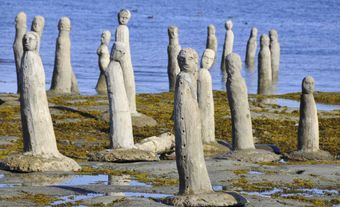Saanich Peninsula, BC, forms part of the Nanaimo Lowlands, along Vancouver Island's east coast. It extends from Sidney in the north to Victoria in the south, and is 33 km long and averages 4 km in width; 90 per cent of its perimeter is fronted by sea. The dominant geographical features are Mount Newton and Saanich Inlet. Elevations in the area range from sea level to just over 305 m (Mount Newton), but generally the peninsula is of relatively low relief, rare for the rugged BC coastline. Besides Sidney and Victoria, the peninsula is organized into 3 other municipalities - Saanich, Central Saanich and North Saanich.
The first inhabitants of the Saanich Peninsula were the Straits Salish who are members of the Central Coast Salish. It is estimated there were about 2000 natives in the area in 1850, most of whom lived at "Sanitch" at Cordova Bay. The name Saanich comes from a Straits Salish word meaning "elevated," perhaps in reference to Mount Newton. In 1850 and in 1852 Sir James Douglas bought large sections of the peninsula from the Straits Salish. In 1858 the land was surveyed and marked into 40 ha allotments; in 1859 the electoral district of Saanich was created. The arrival of the railway gave the area a great boost.
Land on the peninsula is arable and the climate is the mildest in Canada. These qualities, necessary for agriculture, also encourage residential development, and Saanich residents face an almost inevitable urban and suburban encroachment as Metropolitan Victoria grows. Agricultural activity is declining, and land that was formerly forest, pasture or cultivated field is being given over to residential and commercial uses. This has occurred over the past several decades, owing to rising land values and taxes, quarantine restrictions and competition from mainland and California producers. Nevertheless, many full-time and part-time farms show sufficient annual profit to justify their operation. Industrial activity is limited and localized, the most important industries being transportation and tourism. Three ferry terminals on the peninsula provide transportation links to mainland BC, the Gulf Islands and Washington state.

 Share on Facebook
Share on Facebook Share on X
Share on X Share by Email
Share by Email Share on Google Classroom
Share on Google Classroom

